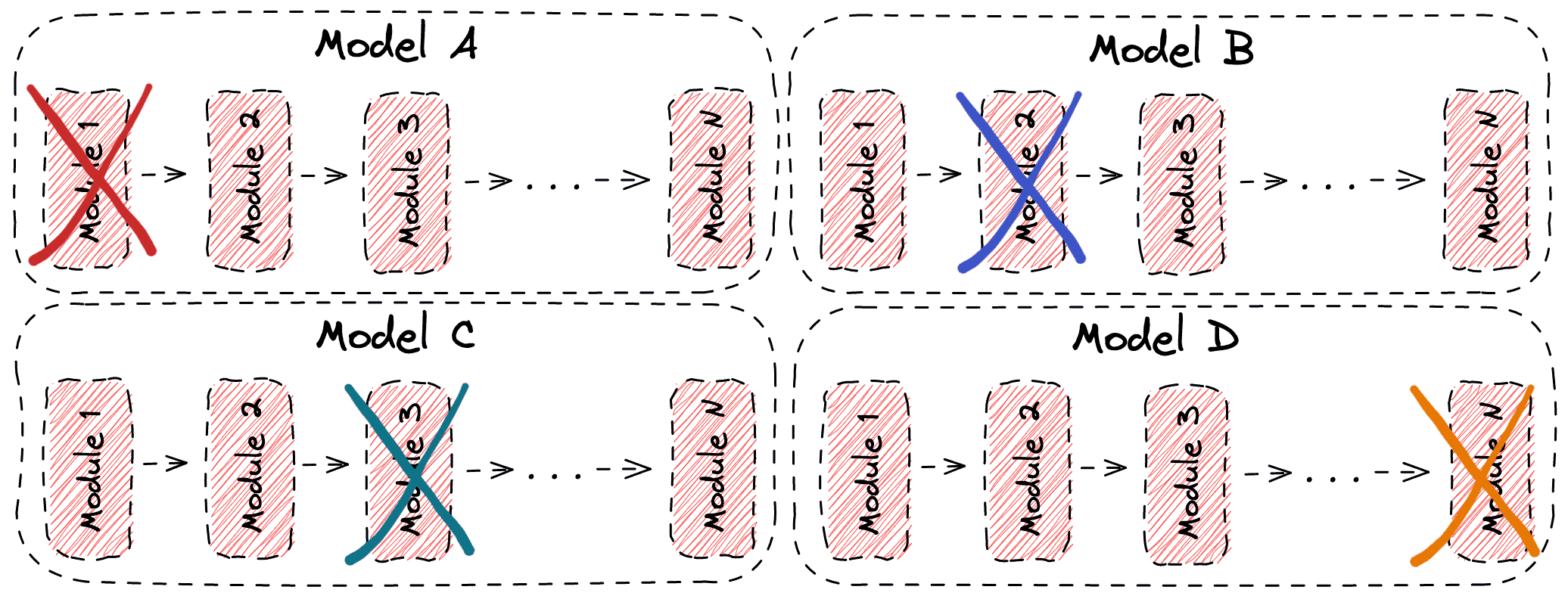1. 概述
本文将深入探讨机器学习领域中一个非常重要的实验方法 —— Ablation Study(消融实验)。我们会从它在生物学中的原始定义谈起,再引申到其在机器学习中的具体含义。接着,我们会说明其重要性,并通过两个实际案例来帮助理解。
2. 生物学中的 Ablation
Ablation 一词最早源自生物学,指通过手术移除器官、异常组织或有害病变部位的医疗手段。在神经科学中,科学家常用“脑组织消融术(ablative brain surgery)”来研究大脑功能。例如,当移除动物大脑某一区域后,若其无法完成某项行为(如抬腿),则可推断该区域与该行为存在因果关系。
✅ 这种“去掉某部分,观察行为变化”的方式,正是 Ablation Study 的核心思想。
3. 机器学习中的 Ablation Study
在机器学习中,模型通常由多个模块组成,每个模块都可能对整体性能产生影响。Ablation Study 的核心目的就是通过有选择性地移除模型中的某些组件,来评估这些组件对最终性能的具体贡献。
我们可以将其类比为“神经网络的消融手术”:
- 原理:去掉模型的一部分,观察效果变化
- 目的:理解模型各部分的作用,验证其必要性
下图展示了一个包含 N 个模块的模型在进行 Ablation Study 时的实验设计:
每次实验移除一个模块,观察模型性能的变化,从而判断该模块的重要性。
4. 为什么要做 Ablation Study?
✅ 快速验证模块价值:无需复杂实验,只需关闭某模块即可评估其影响
✅ 定位性能瓶颈:帮助识别哪些模块对性能提升贡献最大
✅ 模型优化依据:指导我们是否可以简化模型结构,或是否需要加强某部分的设计
✅ 论文加分项:在学术论文中,Ablation Study 是展示模型设计合理性的重要手段之一
举个例子:
在训练一个神经网络时,如果去掉某一层对最终性能影响不大,那这一层可能就是可以优化或删除的冗余结构。
5. 实际案例解析
5.1. 目标检测系统
目标检测任务通常包含以下三个核心模块:
- 目标定位模块:识别图像中物体的位置
- 特征提取模块:通常是一个 CNN 网络,用于提取每个目标的特征
- 分类模块:根据提取的特征判断目标类别
在 Ablation Study 中,我们可以:
- 固定特征提取和分类模块,只替换定位模块,测试其对整体性能的影响
- 或者固定定位和分类模块,更换不同的特征提取网络
这样可以明确每个模块对检测精度的具体贡献,避免多个变量同时变化带来的干扰。
5.2. LSTM 架构分析
LSTM 是一种经典的循环神经网络结构,其每个单元包含三个关键门控机制:
- Forget Gate(遗忘门)
- Input Gate(输入门)
- Output Gate(输出门)
在 Ablation Study 中,研究者常通过移除某一个门结构,观察模型性能变化,从而判断该门的重要性。
例如:
- 移除 Forget Gate 后,模型是否无法记住长期依赖?
- 移除 Input Gate 后,是否影响新信息的输入?
这类研究催生了许多变种结构,如 GRU(Gated Recurrent Unit),就是将 Forget Gate 和 Input Gate 合并的简化设计。
6. 总结
Ablation Study 是一种简单但非常有效的实验方法,广泛应用于机器学习模型的分析与优化中。其核心思想源自生物学中的“消融实验”,通过有控制地移除模型组件,验证其对整体性能的贡献。
✅ 适合用于:
- 模型结构设计的验证
- 模块重要性排序
- 学术论文中的实验支撑
❌ 踩坑提醒:
- 不要一次去掉多个模块,否则无法判断是哪个模块导致性能变化
- 实验设计要保持其他变量一致,否则影响结论的可信度
在实际开发中,建议将 Ablation Study 纳入模型迭代流程,帮助你做出更科学的设计决策。